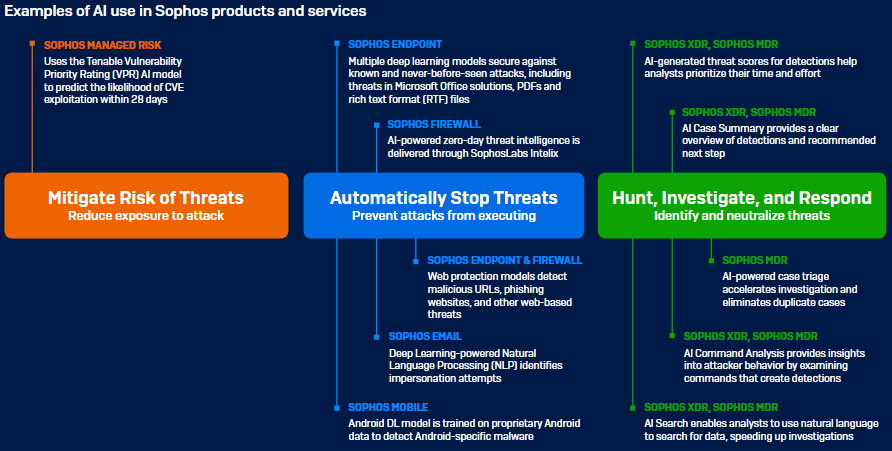All About Sophos AI-Powered Cyber Defences
This week we are looking at Sophos’ AI-powered cyber defences.
Cybersecurity is awash with AI hype. Organisations are bombarded with both alluring promises of AI-powered cybersecurity transformation and dire warnings that AI is ushering in a new era of cyberattacks.
Sophos’ AI-powered cyber defences combine AI technology and human expertise to stop the broadest range of threats, wherever they run,
Deep learning and generative AI capabilities that solve the most critical problems are embedded in Sophos solutions and delivered through the largest AI-native platform in the industry. Training on data from attacks in more than 600,000 diverse customer environments, their adaptive AI-native platform delivers unrivalled defences for our customers and enhances the power of defenders.
What is AI?
AI is a short acronym for Artificial Intelligence which covers a broad range of technologies of varying size and purpose. While generative AI models such as Microsoft Copilot, Chat GPT and Google Gemini are often front of mind with AI, they are just a part of the story.
Sophos use an extensive range of AI models to accelerate cybersecurity, matching the model to the security goal.
- Deep Learning AI (APPLY) – Uses artificial neural networks to recognise patterns and make decisions in a way that mimics the human brain. It applies learnings to perform tasks. For example the Sophos URL Security Model which Detects malicious URLs, phishing websites, and other web-based threats. (This is included in Sophos Endpoint, Sophos Firewall, Sophos Email, Sophos Mobile)
- Generative Al (CREATE) – Creates (generates) brand new content based on the structure and pattern of existing data. For example, the Sophos Al Case Summary tool which provides an easy-to-understand summary of threat activity and recommends next steps. (This is included in Sophos XDR, Sophos MDR.)

The Risks of AI for Cybersecurity
The use of AI in cybersecurity is a two-sided coin. While AI offers tremendous benefits to defenders in the battle against adversaries, it also introduces risks.
Arguably, the biggest risk is the use of AI in cyberattacks – your key focus should be on improving resilience to AI-powered threats. Given that adversaries are primarily leveraging AI to elevate the quality and credibility of phishing emails and scams, it makes sense to focus on these areas.
You could do this by upping your email protection, deploying protection against Business Email Compromise. You could also look into putting processes in pace to mitigate the risk of voice cloning, such as procedures to follow if an unexpected payment or data sharing request is received such as phoning the requester back to verify.
Conclusion
AI offers tremendous benefits for cybersecurity. By avoiding the AI hype and adopting a thoughtful outcome-led approach to AI, organisations can take advantage of this technology to enhance their cyber defences and empower their staff.
Posted in News

